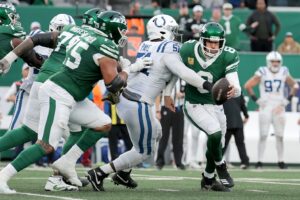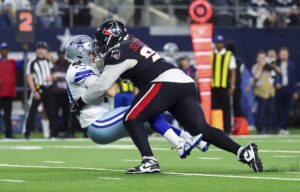Las Vegas Stadium Financing and Relocation Explained
There has been a lot of news this past week on the Las Vegas Stadium financing plan. Starting off on Monday and Tuesday, the Oakland Raiders officially announced to the NFL Stadium and Finance Committee that Bank of America would finance the funding gap . Then on Thursday the Las Vegas Stadium Authority had it’s meeting. Both meetings are expected to be the last before the NFL Owners meet in Phoenix, Arizona on March 26th thru 29th.
To be clear. What is being reported in this article is only valid if the NFL Owners approve the Raiders to relocate to Las Vegas. While that seems highly likely, it is not guaranteed.
With that in mind, lets dig into the guts of this.
The Las Vegas Stadium Authority
The LVSA’s responsibilities per Nevada SB-1 2016. The LVSA will provide the $750 million in state funding through issuing bonds. Also, collect the .88% hotel tax to repay the bonds, set up a waterfall fund, and cover LVSA expenses. The Board will also set aside a percentage of remaining yearly funds to add upgrades to the stadium, and collect sales tax revenue for Clark County. Other responsibilities include, but are not limited to.
- PSL sales to be put towards stadium construction
- Enter into a development agreement with a developer of the Raiders choosing.
- Enter into a lease agreement with the Stadium Events Company
- Ensure the project conforms to all state laws.
- be the final arbiter of any dispute between the Raiders and UNLV.
- Ensure the Raiders have irrevocable funding for the project.
One final note on the LVSA. The Las Vegas Stadium Authority will own both the stadium and the land it sits on. And will not be used as collateral for any loans or debt obligations of the Raiders, or the Stadium Events Company. The LVSA also does not share in any revenue, other than taxes, generated by the stadium. That means no entity listed below will pay any money for leasing or operating the stadium.
The Las Vegas Stadium Developer
The stadium developer is expected to be a subsidiary company of the Raiders. It will be responsible for designing and constructing the project. This includes getting permits, blueprints, infrastructure, hiring sub contractors (15% of which must be located in Nevada), and go through the developmental process with Clark County. Other responsibilities include.
- Creating a development plan that is approved by the LVSA
- Ensure the stadium construction is complete by kickoff of the 2020 NFL season.
- Follow all laws and regulations of the State of Nevada including prevailing wages.
The Raiders will likely bring in many development partners like Legends and others to ensure their vision of a stadium is met, and is also compliant with all laws and regulations. The Raiders also must spend $100 million on the project before tapping into the $750 million offered by the state. The last $50 million of project cost will be paid by the public after the developer has funded 100% of its share of the stadium costs.
The Stadium Events Company
The Stadium Events Company will enter into a lease with the Las Vegas Stadium Authority. This will be an operations agreement for no less than 30 years. The responsibilities of this company are as follows, but not limited to.
- Enter into an operations agreement with the LVSA
- Ensure the proper maintenance and upkeep of the stadium.
- Enter into a lease agreement with the Raiders and NFL
- Enter into a Lease agreement with UNLV that conforms to SB-1 2016
- Actively seek other entertainment and sporting events to host.
- Secure and repay loan from Bank of America.
The Stadium Events Company is expected to be wholly owned as a subsidiary company of the Raiders. The assets and future revenue of this company is what is being used to secure the financing from Bank of America. Since we do not exactly know what the APR is of the $650 million dollar loan, I’ll list a table of possibles below.
- 4% would be a payment of $37,238,393.04 annually.
- 4.5% would be a payment of $39,521,454.12 annually.
- 5% would be a payment of $41,872,086.60 annually.
- 5.5%would be a payment of $44,287,542.12 annually.
All calculation above are assumed to be standard amortization rate over 30 years. Understand this is just an example, but this type of loan has been used before. Levi stadium was financed over 30 years with a 5% APR rate for example.
The previous revenue expectation was between $125-225$ million annually. However new information has come to light. See Below.
University of Nevada Las Vegas.
The University of Nevada Las Vegas will enter into an agreement with the Stadium Events Company. Per SB-1 2016, UNLV is only required to pay game day, and practice operating expenses. The team will have its own locker room, and will be able to sell its own tickets, including club seats, and suites. UNLV also gets to keep all game day revenue, including concessions, digital and changeable signage, as well as, parking.
Negotiations are on going with the Raiders and LVSA as to concession choices, advertising limits, and field markings. However I have it on good authority from Joe Arrigo of Scout.com, the leading insider for the Rebels, these negotiations will result in a lease that is good for all parties.
The Raiders.
It is the responsibility of the Raiders to enter into a lease agreement with the Stadium Events Company. The expected terms of that deal will be for 30 years with an additional (4) five year options. During the first 30 years the Raiders, as long as the contract requirements have been maintained, may not break their lease. Furthermore, they may not even begin negotiations with another city. If they do so the Raiders will be subject to severe damages that have yet to be disclosed. Another expectation will be that the Raiders will be allowed to play between five to ten international home games during the first 30 years.
The Raiders will keep all game day revenue. This will include general tickets, club seats, and suits. Also, they will be responsible for maintenance costs associated with the team’s use of the facility. They will have their own locker room and possibly a Raider Hall of Fame. The expected, team specific, revenue the Raiders are projecting is around $125 million a year.
Naming rights, Rent, and Sponsorships.
Right now it is impossible for me to list which Raiders company will get this money. Barring that which is used by UNLV specific to their game day. The reason for this is simple. Bank of America. I would expect BofA will have required a certain amount of guaranteed revenue to be included in the Stadium Events Company. This could include possible rent from the Raiders. The obvious reason for that is to insure their loan is secured.
What I can tell you is, that what I, and others, have been reporting about the financials could be seriously undervalued. Throughout the SNTIC and legislative process, the financials were pretty consistent. The overall stadium revenue projected out between $250-$350 million annually. It has recently been reported, by Jason Cole of Bleacher Report, and privately, by my sources, that the Stadium Naming Rights and sponsorship deals, that are already signed, blow away the old projections. Those were around $30-$35 million annually.
The way it was explained to me, is that there will be an overall name to the stadium. However there will be an area in each of the four corners that will also get named as well. So far I am hearing numbers exceeding $70 million annually. Not only that, but not all the corners are bought and paid for yet. I am told that this revenue stream could easily be over $100 million annually alone. If what I am hearing is correct, it could actually have NFL Owners sniffing for a bit more money in their pocket in the form of a higher relocation fee. See below.
NFL Relocation procedure.
Article 4.3 of the NFL Constitution and Bylaws covers relocation procedure. The policies of relocation are also modified, and amended, from time to time, by the NFL Commissioner using powers given to him by Article 8.5. What that basically means is that each relocation is fluid and unique. In this forum 24 of 32 owners hold sway and they are only bound by a three-forth majority. All other policies and procedures, rules, and guidelines can, and have been, changed, in past relocation votes. Keep that in mind as I lay out some guidelines that are specific to this relocation below.
The relocation application. The application to relocate is due by February 15th. For this application to be approved the team must exhaust all “reasonable” efforts to remain in the host city, including getting league help. The relocation plan usually requires approval by the 18 member NFL Stadium and Finance Committee. By all accounts, the Raiders have satisfied these requirements. However, having their application approved does not guarantee relocation will be approved.
Once the NFL Owners, and the League Office, are satisfied with the above, they will have a meeting to discuss and possibly vote on relocation. This item is usually put on the agenda roughly a week prior to the meeting. That vote is expected, but not guaranteed, to be during the NFL Owners Meeting, in Phoenix, later this month.
The Relocation Fee
Approval for relocation is actually only a small part of the decision. The real meat and potatoes is in the details. Here is where every relocation is different and unique, the relocation fee.
The relocation fee is money paid to the other 31 NFL Owners. The reason behind this fee is that the other NFL Owners are giving up a territory to the Raiders and they want a slice of that projected revenue. So there are many factors and guidelines considered when coming up with this fee. I’ll list the top three.
- Market size of Las Vegas compared to Oakland.
- New income streams available, compared to old ones.
- The expenses of both locations and their desirability.
Now it has been suggested, for some time, that these considerations should amount to between $250-$350 million dollars. I have reported this range myself. Those numbers were based on projections with Sheldon Adelson as partner. However, as listed above, the Las Vegas Stadium project might be a lot more lucrative than first presented. And from what I am hearing, this could possibly lead to the NFL Owners asking for a little bit more of a slice. Jason Cole of Bleacher Report tweeted that he hear that the owners could be asking for more. Somewhere in $300-$650 million range leaning towards the higher figure.
Repayment of Relocation Fee
Lastly will be the repayment schedule. This will be set during the vote and it could be anywhere from five to twenty years. It all depends on how much the fee is and estimated yearly revenue. The higher the fee the longer the it is expected to be paid back. In the Case of the Raiders, I am hearing either 15 or 20 years. Keep in mind, that the NFL Owners, in this situation, will not want to overly tax the revenue. It is likely these payments will be taken from the Raiders revenue share.
The NFL G-4 Program
The G-4 program, in how it will be used in Las Vegas, is a $200 million dollar loan from NFL Ventures. The interest rate is 2%, which makes it the best loan an NFL Team can get. It is paid for by the incremental Visiting Team Share (VTS) or waived VTS of premium club seats. Yes, you read correctly, the loan is paid back in money that would normally belong to the other NFL Owners.
The annual payment amount of this loan $15,444,204 dollars over 10 years. Should there be a shortfall from the VTS revenue the Raiders would then be responsible for any gap.
So there you have it. After laying this out in detail I hope readers, be it fans or county commissioners, are less confused by the process. I plan to update this once this relocation process is complete, should the Raiders be approved for relocation.






